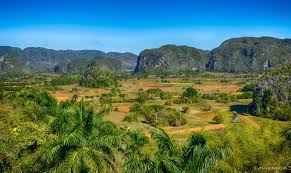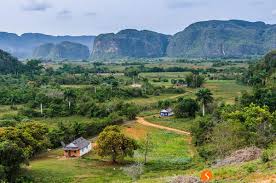 VALLE DE VIÑALES, CUBA, DECLARED BY UNESCO A WORLD HERITAGE OF HUMANITY. VIDEOS / PHOTOS.
VALLE DE VIÑALES, CUBA, DECLARED BY UNESCO A WORLD HERITAGE OF HUMANITY. VIDEOS / PHOTOS.
This beautiful valley is located in the province of Pinar del Río, the westernmost part of Cuba, in the Sierra de los Órganos, exactly in the mountainous group of the Cordillera de Guaniguanico. The Valley and much of the mountains that surround it were approved in 1999 as a National Park and, in December of that same year, it was declared a World Heritage Site by UNESCO, in the category of Cultural Landscape. It also has the status of a Cuban National Monument.
It is one of the best known and most attractive areas of Cuba, it presents an exceptional setting, which, among others, is characterized by the fusion of its spectacular natural beauty, conservation of the environment, the harmonious action of man in the cultivation of minor fruits, forage and essentially the cultivation of tobacco, whose traditional methods of cultivation and production achieve universal recognition of the cigar as one of the best quality in the world.
There are some mountainous formations, unique on the Island, called mogotes. These mogotes constitute very unique geomorphological formations, of the great diversity of shapes, which in some cases measure hundreds of meters in height. They are only comparable with those located in China and the Malay Peninsula. In the valley, there are other elevations, such as Alturas de Pizarras, which are made up of a variety of rocks, the oldest existing throughout the country and also in the Caribbean area.
CAVES.
In the Valley, you can find several caves, very significant in terms of shape and originality, such as “José Miguel” and “Indio”. The last one is a cavern, which reaches 300 meters in length, in which 2 underground rivers run. There is also the so-called “Queen of the speluncas”, the Great Cavern of Santo Tomás which is much larger, but not so accessible and perhaps not so attractive to the general public.
In the Cueva del Indio, in addition to the various forms and figures formed by stalactites and stalagmites, paintings and remains of utensils and burials of pre-Columbian Cuban cultures have been found. This cave is located near the road from Viñales to San Cayetano. About five and a half kilometers from the city of Viñales, before reaching San Vicente.
FLORA AND FAUNA.
Regarding its flora, it is classified as having an atypical evolution, very varied in terms of species with characteristics of relics from the past; There are around 17 endemic botanical species in the Valley that are not found elsewhere in the world. Its greatest exponent is the Mycrocycas Calocoma, known as Palma Cork, the only species declared a National Monument. It is a 150 million-year-old living fossil, the oldest palm in the Antilles, which has the botanical peculiarity of fixing nitrogen in the atmosphere due to a bacterium called Beijerinckia, which lives inside this plant. This phanerogamic species of living fossil is particularly abundant in the territory near the Valley.
Fauna is relevant for its marked differentiation, and it is the union of the different ecosystems that favors its diversity. The highest specific richness and individuals by species are found in the ecotones or transition zones. This site has a great variety of birds, reptiles, mammals, and mollusks; among the invertebrates, the presence of endemics can be mentioned, as is the case of the Papilionidae family with the Parides Gundlachianus species.
GEOMORPHOLOGY.
From the geomorphological point of view, different types of relief are manifested in the Viñales Valley where they appear:
– Erosive tectonic mountains carved out of limestone in the form of tables and mogotes. These are impressive and can appear singly or in groups; Its slopes are vertical and its rounded peaks are generally aligned and separated by deep narrow canyons, with slopes exceeding 25%.
– Erosive tectonic mountains carved out of terrigenous rocks in the shape of hills. These elevations are highly dissected, both vertically and horizontally, their slopes are in the range of 15-25%. The heights do not exceed 300 meters, the hills are flattened at the top.
– Heights up to 200 meters. They are relics of Jurassic limestones that are similar to calcareous mountains, differing from them by the greater degree of erosion and karstification.
– Fluvial-marine plain. This plain coincides with the Viñales Valley. It has a flat to slightly wavy shape, generally, it develops on carbonate rocks. The heights rarely exceed 120 meters, this plain also corresponds to the marginal poljas.
– Tectonic scarp – denudative. The height exceeds 150 meters, between one structure and another they can have a difference greater than 30 meters; slopes exceed 10%.
ARCHEOLOGY.
In the Viñales area, 47 archaeological sites are known. Of these, 19 are linked to aboriginal communities from the pre-Hispanic period of Cuban history, where evidence of their funeral rites can be found, and 28 are related to maroon slaves of African origin. The latter are thought to have been the whereabouts of gangs or true palenques of the 19th century.
 VALLE DE VIÑALES, CUBA, DECLARADO POR LA UNESCO PATRIMONIO DE LA HUMANIDAD. PHOTOS.
VALLE DE VIÑALES, CUBA, DECLARADO POR LA UNESCO PATRIMONIO DE LA HUMANIDAD. PHOTOS.
Este hermoso valle está ubicado en la provincia de Pinar del Río, zona más occidental de Cuba, en la Sierra de los Órganos, exactamente en el grupo montañoso de la Cordillera de Guaniguanico. El Valle y gran parte de la sierra que lo rodea fue aprobado en 1999 como Parque Nacional y, en diciembre de ese mismo año, fue declarado por la UNESCO Patrimonio de la Humanidad, en la categoría de Paisaje Cultural. Posee además la condición de Monumento Nacional Cubano.
Es una de las áreas más conocidas y atractivas de Cuba, presenta un escenario excepcional, que, entre otras, lo caracteriza la fusión de su espectacular belleza natural, conservación del medio ambiente, la armónica acción del hombre en el cultivo de frutos menores, forraje y esencialmente el cultivo del tabaco, cuyos métodos tradicionales de cultivo y producción, logran el reconocimiento universal del habano como uno de los de mejor calidad del mundo.
Existen unas formaciones montañosas, únicas en la Isla, llamadas mogotes. Estos mogotes constituyen formaciones geomorfológicas muy singulares, de gran diversidad de formas, que llegan a medir, en algunos casos, centenares de metros de altura. Sólo son comparables con las localizadas en China y la Península de Malaca. En el valle existen otras elevaciones, como Alturas de Pizarras, las cuales están constituidas por una variedad de rocas, las más antiguas existentes a lo largo del país y también en el área caribeña.
CUEVAS.
En el Valle se pueden encontrar varias cuevas, muy significativas en cuanto a forma y originalidad, como la de “José Miguel” y la del “Indio”. La última es una caverna, que llega a alcanzar los 300 metros de extensión, en cuyo interior corren 2 ríos subterráneos. También está la denominada “La reina de las espeluncas”, la Gran Caverna de Santo Tomás que es mucho mayor, pero no tan accesible y tal vez no tan atractiva para el público en general.
En la Cueva del Indio, además de las diversas formas y figuras formadas por las estalactitas y estalagmitas, se han encontrado pinturas y restos de los utensilios y entierros de las culturas cubanas precolombinas. Esta cueva se encuentra próxima a la carretera de Viñales a San Cayetano. A unos cinco y medio kilómetros de la ciudad de Viñales, antes de llegar a San Vicente.
FLORA Y FAUNA.
Con relación a su flora, ésta se clasifica de una evolución atípica, muy variada en términos de especies con características de reliquias del pasado; existen en el Valle alrededor de 17 especies botánicas Endémicas que no se encuentran en otro lugar del mundo. Su máximo exponente es la Mycrocycas Calocoma , conocida como Palma corcho, única especie declarada Monumento Nacional. Se trata de un fósil viviente de 150 millones de años de edad, la palma más antigua de las Antillas, que tiene la particularidad botánica de fijar el nitrógeno en la atmósfera debido a una bacteria llamada Beijerinckia, que vive dentro de esta planta. Esta especie fanerógama de fósil viviente, es particularmente abundante en el territorio cercano al Valle.
La fauna es relevante por su marcada diferenciación, y es la unión de los diferentes ecosistemas la que favorece su diversidad. La mayor riqueza específica e individuos por especies, se encuentra en los ecotonos o zonas de transición. Este sitio posee una gran variedad de aves, reptiles, mamíferos y moluscos; entre los invertebrados puede mencionarse la presencia de endémicos, como es el caso de la familia Papilionidae con la especie Parides Gundlachianus.
GEOMORFOLOGIA.
Desde el punto de vista geomorfológico en el Valle de Viñales se manifiestan diferentes tipos de relieve donde aparecen:
– Montañas tectónico erosivas labradas en calizas en forma de mesas y mogotes. Estas son impresionantes y pueden aparecer aisladas o en grupos; sus laderas son verticales y sus cimas redondeadas, se encuentran alineadas por lo general y separadas por profundos cañones estrechos, con pendientes que superan el 25%.
– Montañas tectónico erosivas labradas en rocas terrígenas en forma de cerros. Estas elevaciones se encuentran muy diseccionadas, tanto vertical como horizontalmente, sus pendientes son del rango de 15-25%. Las alturas no sobrepasan los 300 metros, los cerros son aplanados en la cima.
– Alturas hasta 200 metros. Son relictos de calizas jurásicas que son similares a las montañas calcáreas, diferenciándose de éstas por el mayor grado de erosión y carsificación.
– Llanura fluvio-marina. Esta llanura coincide con el Valle de Viñales. Tiene forma plana a ligeramente ondulada, generalmente se desarrolla sobre rocas carbonatadas. Las alturas pocas veces sobrepasan los 120 metros, esta llanura además se corresponde con las poljas marginales.
– Escarpe tectónico – denudativo. La altura supera los 150 metros, entre una y otra estructura pueden llegar a tener una diferencia mayor de 30 metros; las pendientes sobrepasan el 10%.
ARQUEOLOGIA.
En el área de Viñales se conocen 47 sitios arqueológicos. De ellos, 19 están vinculados a comunidades aborígenes de la época prehispánica de la Historia de Cuba, donde pueden encontrarse evidencias de sus ritos funerarios, y 28 están relacionados con esclavos cimarrones de origen africano. Estos últimos se piensa que hayan sido paradero de cuadrillas o verdaderos palenques del siglo XIX.
Agencies/ Wiki/ EcuRed/ Internet Photos/ YouTube/ Arnoldo Varona/ www.TheCubanHistory.com
THE CUBAN HISTORY, HOLLYWOOD.



 VALLE DE VIÑALES, Cuba, declared by UNESCO a World Heritage of Humanity. * VALLE DE VIÑALES, Cuba, declarado por la UNESCO Patrimonio de la Humanidad. VIDEOS / PHOTOS.
VALLE DE VIÑALES, Cuba, declared by UNESCO a World Heritage of Humanity. * VALLE DE VIÑALES, Cuba, declarado por la UNESCO Patrimonio de la Humanidad. VIDEOS / PHOTOS.







